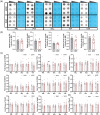No significant change of N6 -methyladenosine modification landscape in mouse brain after morphine exposure
- PMID: 38376052
- PMCID: PMC10757896
- DOI: 10.1002/brb3.3350
No significant change of N6 -methyladenosine modification landscape in mouse brain after morphine exposure
Abstract
Objectives: N6 -methyladenosine (m6 A) plays a crucial role in regulating neuroplasticity and different brain functions at the posttranscriptional level. However, it remains unknown whether m6 A modification is involved in acute and chronic morphine exposure.
Materials and methods: In this study, we conducted a direct comparison of m6 A levels and mRNA expression of m6 A-associated factors between morphine-treated and nontreated C57BL/6 wild-type mice. We established animal models of both acute and chronic morphine treatment and confirmed the rewarding effects of chronic morphine treatment using the conditioned place preference (CPP) assay. The activation status of different brain regions in response to morphine was assessed by c-fos staining. To assess overall m6 A modification levels, we employed the m6 A dot blot assay, while mRNA levels of m6 A-associated proteins were measured using a quantitative polymerase chain reaction (qPCR) assay. These analyses were performed to investigate whether and how m6 A modification and m6 A-associated protein expression will change following morphine exposure.
Results: The overall m6 A methylation and mRNA levels of m6 A-associated proteins were not significantly altered in brain regions that were either activated or not activated during acute morphine stimulation. Similarly, the overall m6 A modification and mRNA levels of m6 A-associated proteins remained unaffected in several key brain regions associated with reward following chronic morphine exposure.
Conclusion: This study showed that the overall m6 A modification level and mRNA expression levels of m6 A-associated factors were not affected after acute and chronic morphine exposure in different brain regions, indicating m6 A modification may not be involved in brain response to morphine exposure.
Keywords: N6-methyladenosine; epigenetics; morphine; opioid; posttranscriptional RNA modification; reward.
© 2023 The Authors. Brain and Behavior published by Wiley Periodicals LLC.
Conflict of interest statement
The authors declare no conflict of interest.
Figures




Similar articles
-
Morphine and ethanol pretreatment effects on expression and extinction of ethanol-induced conditioned place preference and aversion in mice.Psychopharmacology (Berl). 2021 Jan;238(1):55-66. doi: 10.1007/s00213-020-05658-x. Epub 2020 Sep 26. Psychopharmacology (Berl). 2021. PMID: 32980910 Free PMC article.
-
Forebrain PENK and PDYN gene expression levels in three inbred strains of mice and their relationship to genotype-dependent morphine reward sensitivity.Psychopharmacology (Berl). 2010 Feb;208(2):291-300. doi: 10.1007/s00213-009-1730-1. Epub 2009 Dec 9. Psychopharmacology (Berl). 2010. PMID: 19997907
-
Extinction of opiate reward reduces dendritic arborization and c-Fos expression in the nucleus accumbens core.Behav Brain Res. 2014 Apr 15;263:51-9. doi: 10.1016/j.bbr.2013.12.041. Epub 2014 Jan 7. Behav Brain Res. 2014. PMID: 24406724
-
The rewarding action of acute cocaine is reduced in β-endorphin deficient but not in μ opioid receptor knockout mice.Eur J Pharmacol. 2012 Jul 5;686(1-3):50-4. doi: 10.1016/j.ejphar.2012.04.040. Epub 2012 May 2. Eur J Pharmacol. 2012. PMID: 22575525 Free PMC article.
-
[The Roles of N6-Methyladenosine Modification and Its Regulators in Male Reproduction].Sichuan Da Xue Xue Bao Yi Xue Ban. 2024 May 20;55(3):527-534. doi: 10.12182/20240560103. Sichuan Da Xue Xue Bao Yi Xue Ban. 2024. PMID: 38948273 Free PMC article. Review. Chinese.
Cited by
-
An Investigation of the RNA Modification m6A and Its Regulatory Enzymes in Rat Brains Affected by Chronic Morphine Treatment and Withdrawal.Int J Mol Sci. 2025 May 4;26(9):4371. doi: 10.3390/ijms26094371. Int J Mol Sci. 2025. PMID: 40362608 Free PMC article.
-
N6-methyladenosine methylation: a novel key to unlocking mental disorders.Int J Neuropsychopharmacol. 2025 Jul 23;28(7):pyaf044. doi: 10.1093/ijnp/pyaf044. Int J Neuropsychopharmacol. 2025. PMID: 40590504 Free PMC article. Review.
References
-
- Almeida‐Santos, A. F. , Gobira, P. H. , Souza, D. P. , Ferreira, R. C. M. , Romero, T. R. , Duarte, I. D. , Aguiar, D. C. , & Moreira, F. A. (2014). The antipsychotic aripiprazole selectively prevents the stimulant and rewarding effects of morphine in mice. European Journal of Pharmacology, 742, 139–144. 10.1016/j.ejphar.2014.09.004 - DOI - PubMed
-
- Bazov, I. , Sarkisyan, D. , Kononenko, O. , Watanabe, H. , Taqi, M. M. , Stålhandske, L. , Verbeek, D. S. , Mulder, J. , Rajkowska, G. , Sheedy, D. , Kril, J. , Sun, X. , Syvänen, A.‐C. , Yakovleva, T. , & Bakalkin, G. (2018). Neuronal expression of opioid gene is controlled by dual epigenetic and transcriptional mechanism in human brain. Cerebral Cortex, 28(9), 3129–3142. 10.1093/cercor/bhx181 - DOI - PMC - PubMed
-
- Bokar, J. A. , Shambaugh, M. E. , Polayes, D. , Matera, A. G. , & Rottman, F. M. (1997). Purification and cDNA cloning of the AdoMet‐binding subunit of the human mRNA (N6‐adenosine)‐methyltransferase. RNA, 3(11), 1233–1247. https://www.ncbi.nlm.nih.gov/pubmed/9409616 - PMC - PubMed
Publication types
MeSH terms
Substances
Grants and funding
- 31922026/National Natural Science Foundation of China
- U20A2016/National Natural Science Foundation of China
- 2018YFA0801401/National Key Research and Development Program of China
- ZDSYS20190902093601675/Shenzhen Science and Technology Innovation Program
- 2019B151502007/Basic and Applied Basic Research Foundation of Guangdong Province
LinkOut - more resources
Full Text Sources

